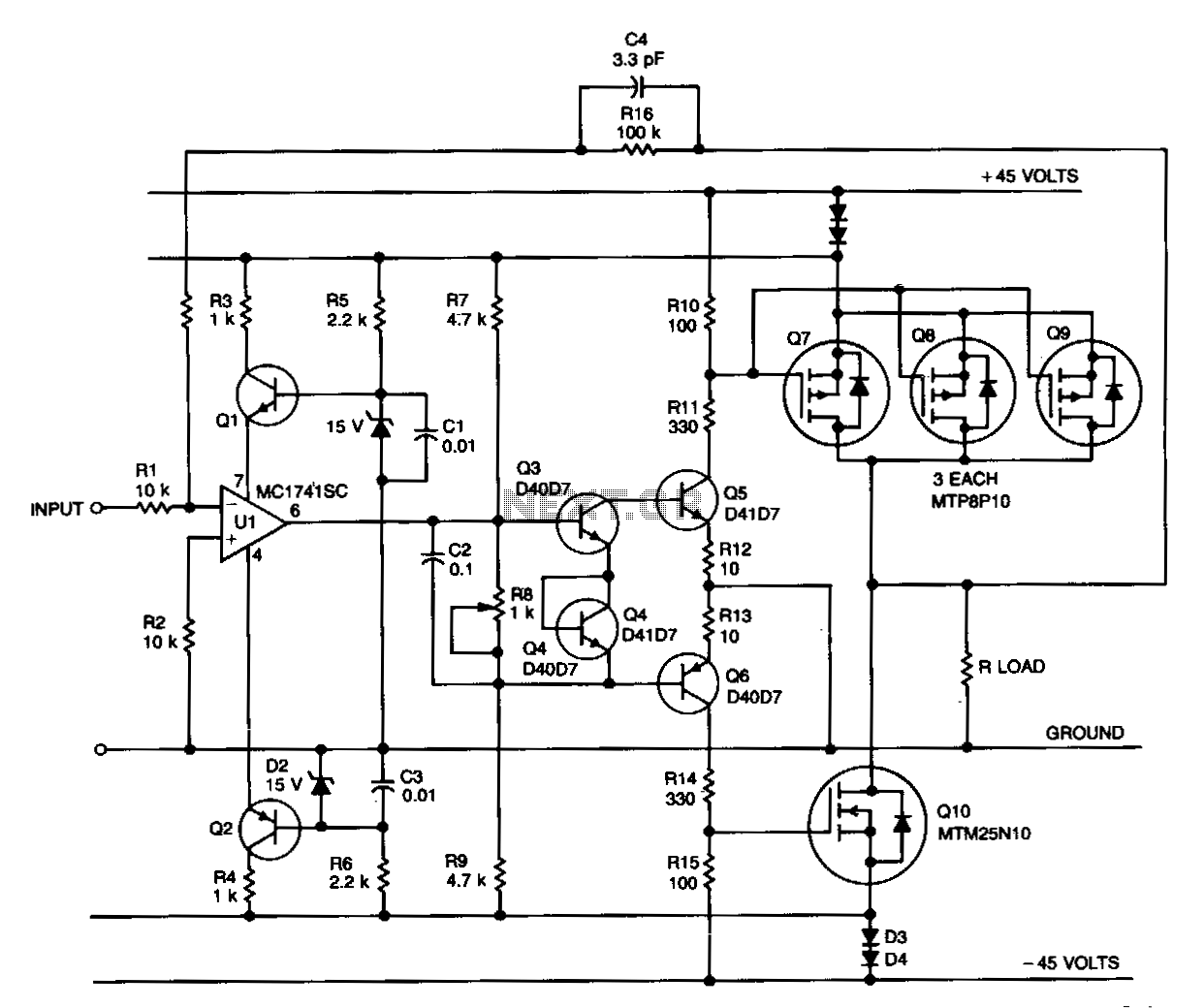
50W-audio-power-amplifier

This audio amplifier design utilizes TMOS Power FETs configured in a complementary common-source arrangement. The FETs are biased to cutoff and can rapidly turn on when a signal is applied. This design approach offers significant thermal stability in the output stage. U1 functions as a high slew-rate amplifier that drives transistors Q3, Q4, and Q6, which operate in class AB mode, facilitating level transitions for the output stage comprised of Q7, Q8, Q9, and Q10. The positive temperature coefficient of the TMOS devices allows for parallel operation of Q7, Q8, and Q9, while also providing a higher power complementary device for Q10. To achieve high turn-on speeds, these TMOS Power FETs must be driven from a low-source impedance of 100 ohms.
The audio amplifier circuit employs TMOS Power FETs in a complementary common-source configuration, which is notable for its efficiency and thermal management. In this setup, the FETs are initially biased to the cutoff region, allowing for quick activation in response to input signals. This characteristic is essential for maintaining audio fidelity, as it minimizes distortion during dynamic signal transitions.
The role of U1, as a high slew-rate amplifier, is critical in ensuring that the input signal is rapidly and accurately translated to the output stage. The transistors Q3, Q4, and Q6 are configured to operate in class AB, which strikes a balance between linearity and efficiency. This configuration is particularly advantageous in audio applications where signal integrity is paramount.
The output stage, consisting of Q7, Q8, Q9, and Q10, is designed to handle significant power demands while maintaining stability. The positive temperature coefficient of the TMOS devices facilitates the parallel operation of Q7, Q8, and Q9, which helps distribute the thermal load and enhances reliability. Furthermore, Q10 serves as a higher power complementary device, ensuring that the output stage can deliver the necessary power without compromising performance.
To achieve optimal performance, it is crucial that the TMOS Power FETs are driven from a low-source impedance of 100 ohms. This requirement ensures that the FETs can switch on quickly, which is vital for high-frequency audio applications. The overall design emphasizes a combination of speed, stability, and power efficiency, making it suitable for high-performance audio amplification tasks.This audio amplifier design approach employs TMOS Power FETs operating in a complementary common- source configuration. They are biased to cutoff, then turn on very quickly when a signal is applied. The advantage of this approach is that the output stage is very stable from a thermal point of view. U1 is a high slew-rate amp that drives Q3, Q4,and Q6 (operating class AB) providing level transition for the output stage consisting of Q7, QS, Q9,and QlO.
The positive temperature coefficient of the TMOS device enables parallel operation of Q7, QS, and Q9 and provides a higher power complementary device for QlO. These TMOS Power FETs must be driven from a low-source impedance of 100 0, in order to actually obtain high turn-on speeds.
🔗 External reference
The audio amplifier circuit employs TMOS Power FETs in a complementary common-source configuration, which is notable for its efficiency and thermal management. In this setup, the FETs are initially biased to the cutoff region, allowing for quick activation in response to input signals. This characteristic is essential for maintaining audio fidelity, as it minimizes distortion during dynamic signal transitions.
The role of U1, as a high slew-rate amplifier, is critical in ensuring that the input signal is rapidly and accurately translated to the output stage. The transistors Q3, Q4, and Q6 are configured to operate in class AB, which strikes a balance between linearity and efficiency. This configuration is particularly advantageous in audio applications where signal integrity is paramount.
The output stage, consisting of Q7, Q8, Q9, and Q10, is designed to handle significant power demands while maintaining stability. The positive temperature coefficient of the TMOS devices facilitates the parallel operation of Q7, Q8, and Q9, which helps distribute the thermal load and enhances reliability. Furthermore, Q10 serves as a higher power complementary device, ensuring that the output stage can deliver the necessary power without compromising performance.
To achieve optimal performance, it is crucial that the TMOS Power FETs are driven from a low-source impedance of 100 ohms. This requirement ensures that the FETs can switch on quickly, which is vital for high-frequency audio applications. The overall design emphasizes a combination of speed, stability, and power efficiency, making it suitable for high-performance audio amplification tasks.This audio amplifier design approach employs TMOS Power FETs operating in a complementary common- source configuration. They are biased to cutoff, then turn on very quickly when a signal is applied. The advantage of this approach is that the output stage is very stable from a thermal point of view. U1 is a high slew-rate amp that drives Q3, Q4,and Q6 (operating class AB) providing level transition for the output stage consisting of Q7, QS, Q9,and QlO.
The positive temperature coefficient of the TMOS device enables parallel operation of Q7, QS, and Q9 and provides a higher power complementary device for QlO. These TMOS Power FETs must be driven from a low-source impedance of 100 0, in order to actually obtain high turn-on speeds.
🔗 External reference
Warning: include(partials/cookie-banner.php): Failed to open stream: Permission denied in /var/www/html/nextgr/view-circuit.php on line 713
Warning: include(): Failed opening 'partials/cookie-banner.php' for inclusion (include_path='.:/usr/share/php') in /var/www/html/nextgr/view-circuit.php on line 713